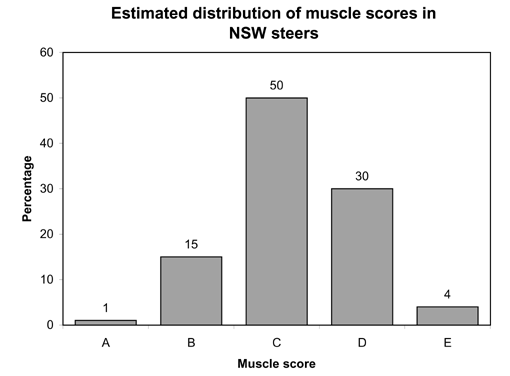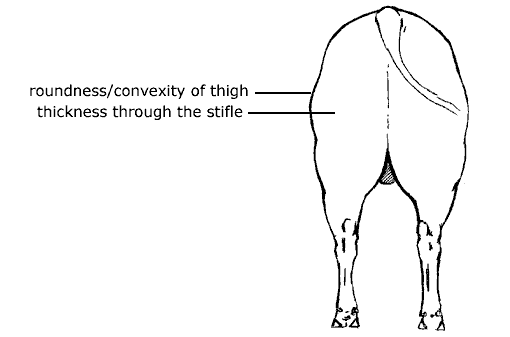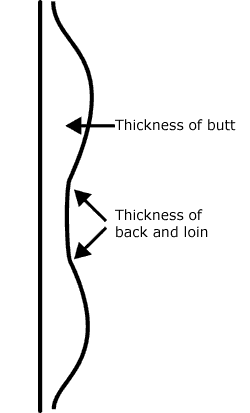The Total Weight of Muscle in a Beef Animal Is
Introduction
The shape of an animal or carcase can be evaluated in a number of means. HOW shape is evaluated is the biggest determinant of the usefulness of the evaluation.
This Agnote defines the differences in types of shape evaluations and explains WHY 1 shape evaluation, 'Muscle Score', is a useful description of animal value.
Conformation
One of the most common methods is to evaluate the shape of an animal or carcase, assuasive fatness to play its total function in determining that shape. This method is commonly referred to as 'conformation'. When this method of shape cess is evaluated, results show that as 'conformation' score increases, fatness increases. Meat yield in the boning room consequently decreases. The conclusion drawn from these studies is that increasing conformation score is at best of little use (when fatness doesn't vary greatly) and at worst detrimental to improved beef production (boning room yield).
Muscle score
Information technology has been conspicuously shown in experiments that a score tin can be given independent of fatness. In Commonwealth of australia, this score is known every bit 'muscle score'. Muscle score, unlike conformation, is a measure of shape without the influence of fatness. This is the important departure between conformation and muscle score. As with conformation, muscle score is an evaluation of the thickness (quantity), a three dimensional view of the whole body (run into the Primefact on Muscle scoring beefiness cattle). Every bit 'muscle score' increases, so too does meat yield. Information technology has been shown that when carcases from animals of the same measured subcutaneous fat depth simply dissimilar muscle scores are boned out to meat, fat and os, the higher muscled-scored beast not simply has more total meat simply also has less total fat than the lower muscle-scored animal.
It has even been shown that pick for muscle score in bulls resulted in their progeny beingness not only higher in muscle score but as well lower in both subcutaneous and total carcase fatness.
Butt contour
'Butt Profile' is a shape index developed by Ausmeat in Commonwealth of australia to depict the shape of a carcase butt. Information technology is a two dimensional view of the carcase as seen from the side. Equally with conformation score it is significantly affected by carcase fatness. It is included in the Ausmeat Carcase Linguistic communication.
Confusion of Terms
Unfortunately, all three of these 'scores' (conformation, butt profile and musculus score) have used the same scoring terminology, 'A' for a loftier score and 'E' for a low score. The inference is that they are all the same, but they are non the same.
Fatty influences both conformation and barrel profile, resulting in neither existence of much use in determining animal or carcase value, over and above a measurement or cess of fatness. Whereas muscle score, considering it is evaluated contained of fatness, adds to the prediction of beast or carcase value over and in a higher place an assessment of fatness alone.
The departure between butt profile and muscle score
Barrel profile
Butt profile is based on a two dimensional view of the carcase equally seen from the side.
This shape is not adjusted for fatness and hence the fatter the carcase the more the convexity, and the higher the score.
Transposing the butt profile view onto a live fauna, it is:

Musculus Score
Alive musculus score is the thickness and convexity of the animal, relative to its size, discounting for sub-cutaneous fat.
It is mainly based on a view of the hindquarter.
| | |
Equally seen on a carcase, muscle score is appraised as:
Discounting for subcutaneous fat:
- Butt shape is a two-dimensional evaluation.
- Carcase muscle score is a 3-dimensional evaluation (information technology evaluates volume).
In summary
Butt profile and muscle score are totally dissimilar views of the creature.
- Butt profile is side view only and relies on convexity seen from the side (2-dimensional evaluation).
- Musculus score is back view and relies primarily on thickness (and hence volume) as seen from behind (three-dimensional evaluation).
- Muscle score discounts for fatness, butt profile does non.
It is important that the two shape evaluations non be confused, even though both use scores from A to E.
Live muscle scorers should not utilize Ausmeat Barrel Profile to examination their ability as muscle scorers because they are completely different evaluations of shape.
Barrel profile is of piffling use in evaluating carcase worth.
Research results on alive muscle score
Two major enquiry projects were funded past NSW Agronomics and the Meat Research Council in 1988 and 1990 (Perry et al, 1993 (a)&(b)).
Both projects concluded that live muscle score in combination with an assessment of subcutaneous fatty improved the prediction of saleable meat yield. The second project also showed that alive muscle score was not being influenced past subcutaneous fat or inter-muscular fat (fat betwixt the muscles).
For each increase in muscle score at the aforementioned live weight and fat depth, dressing percentage increased by 1.7%. Saleable meat yield pct increased by 1.v to ane.seven % and lean meat yield (denuded of fatness) increased by over 2%. In lightweight steers, this equated to x–15% increase in value.
Tables three and 4 (below) evidence how fat score and muscle score influence the economically productive characteristics of dressing percentage and retail meat yield.
Dressing % = (Carcase weight ÷ live weight) x 100
| Muscle score | |||
|---|---|---|---|
| Fatty score | B | C | D |
| 2 | 55.9 | 53.ix | 53.0 |
| 3 | 56.six | 54.7 | 53.7 |
| four | 57.6 | 55.7 | 54.seven |
Table 3 shows that every bit fat score increases, dressing % increases equally much of the actress fat remains on the carcase. This helps to explain why many livestock buyers, long after lean animals were preferred, continued to purchase fatter animals equally they were often judged on their aptitude as buyers, by dividing the price they paid for a alive fauna past the carcase weight.
Retail meat yield = (weight of saleable meat ÷ carcase weight) x 100
| Alive Muscle Score | |||
|---|---|---|---|
| Fat Score | B | C | D |
| two | 72.three | lxx.5 | 69 |
| 3 | 71 | 69.four | 67.7 |
| four | lxx | 68.2 | 66.6 |
Tabular array iv illustrates the problem with increasing fatness and decreasing yield. Too, musculus score's influence on both dressing % (Table 3) and retail meat yield % (Table iv) is conspicuously evident.
Repeatability of musculus scores
One of the most oftentimes asked questions of a subjective appraisal system such every bit muscle score is 'how repeatable is it between assessors, within assessors scoring the same animal twice, and the aforementioned animal over time as it matures and fattens?'.
Research studies in Australia on muscle score repeatability have shown that inside and betwixt experienced assessors, muscle scoring is quite repeatable.
More contempo research work in NSW and South Australia indicates that musculus score tin exist a useful tool for describing shop animals for their future operation as finished carcases.
Implications of increased muscling for the breeding herd
There is little sound scientific information on the correlated response to option for muscling on other productive characteristics of beef production.
Research work in 1995 indicated no adverse relationship between growth rate and increased musculus when musculus selection was carried out in combination with weight selection. This inquiry also showed no adverse reaction from using loftier-muscled bulls, of the same breed, on heifers for their offset calf. The indications are that weight of dogie is the culprit for increasing dystocia and not muscle shape.
In fact, there is some circumstantial evidence that moderate increases in muscularity in the female person, which can ofttimes be accompanied by improved pelvic surface area dimensions, could in fact reduce dystocia levels.
The perception that more than-muscular females are less productive in terms of milk production and fertility has yet to exist proven. However, it does highlight the fact that singular selection for 1 trait is not appropriate. It could be expected that extremes of muscularity volition have an adverse impact on role.

Current level of muscling in the NSW beefiness herd
The graph beneath is an estimate of the distribution of muscling in the cattle herd of NSW. It was derived from a survey conducted by NSW Agriculture in 1989 (roughly 2,000 slaughter steers in the northern half of the Land).
Female person muscle scores would be, on average, well-nigh 2/iii of a muscle score lower than the steers.
This means that the present level of muscularity in the beef cattle herd averages D to C-, which is quite low. Apparently there is plenty of room to increase muscularity inside the general cattle herd earlier extremes or even heavy muscularity (B+ to A) become common.
Further reading
McKiernan, Due west.A. (1990) 'New developments in live animal appraisal of meat quantity in beef cattle'. Proc. 8th. Conf. Aust. Assoc. Anim. Breed. and Genet. pp 447-50. Hamilton, New Zealand.
McKiernan, W.A. (1995) 'Growth, Carcase Value and Body Measurements from High and Low Muscled Bulls'. M.Sc. Thesis, Academy of New South Wales.
McKiernan, W.A. and Robards, One thousand.E. (1996) 'The Repeatability of Muscle Score in Beef Animals Betwixt Birth and Twenty Months of Age'. Proc. Aust. Soc. Anim. Prod. 21 : 151-54.
McKiernan, Westward.A. and Robards, One thousand.Eastward. (1997) 'Growth Functioning of Steers Sired Past Loftier and Low Muscle Scored Bulls'. Proc. Assoc. Advmt. Anim. Breed. Genet. Vol 12.
McKiernan, Westward.A., Hoffman, W., Barwick, S.A. and Johnston, D.J. (1998) 'Feeder Steer Assessments that are Guides to Feedlot and Carcase Operation'. Proc. NSW Beefiness Products Conference, Armidale.
Perry, D. and McKiernan, W. A. (1994) 'Growth and dressing percentage of well and average muscled Angus steers'. Proc. Aust. Soc. Anim. Prod. twenty : 349-50.
Perry, D., McKiernan, Due west.A. and Yeates, A.P. (1993a) 'Muscle score: its usefulness in describing the potential yield of saleable meat from live steers and their carcases. Aust. J. Exp. Agr. 33 : 275-81.
Perry, D., Yeates, A.P. and McKiernan, Westward.A. (1993b) 'Meat yield and subjective muscle scores in medium weight steers'. Aust. J. Exp. Agr. 33 : 825-31.
Source: https://www.dpi.nsw.gov.au/animals-and-livestock/beef-cattle/appraisal/publications/shape-muscle-score


0 Response to "The Total Weight of Muscle in a Beef Animal Is"
Post a Comment